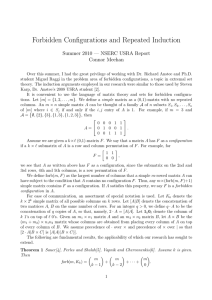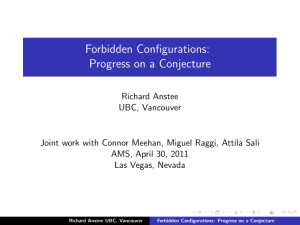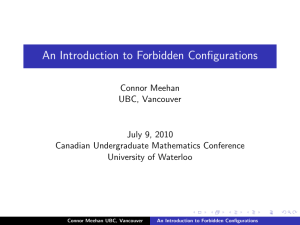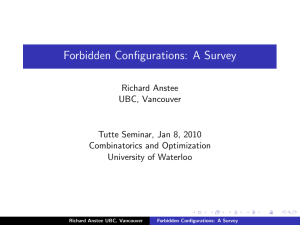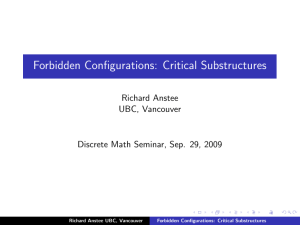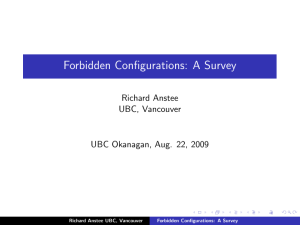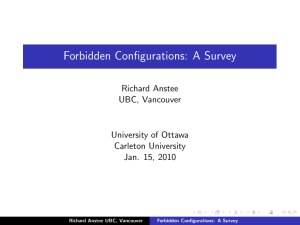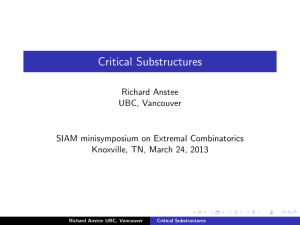Summer 2014 NSERC USRA Report Families of Forbidden Configurations Maxwell Allman
advertisement
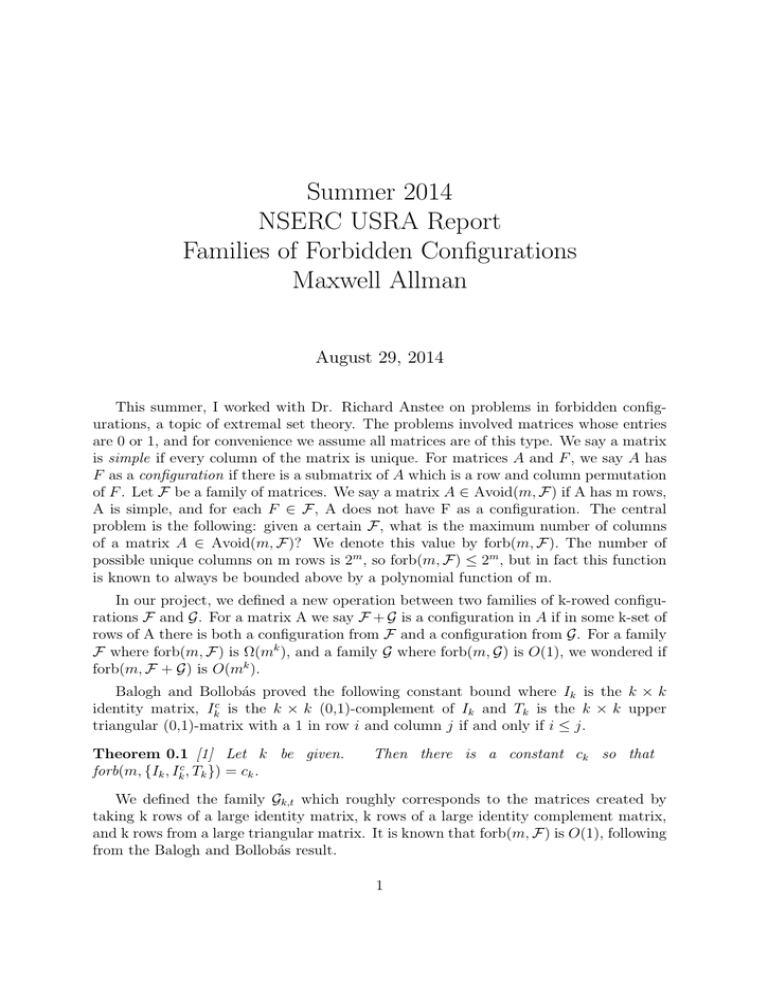
Summer 2014
NSERC USRA Report
Families of Forbidden Configurations
Maxwell Allman
August 29, 2014
This summer, I worked with Dr. Richard Anstee on problems in forbidden configurations, a topic of extremal set theory. The problems involved matrices whose entries
are 0 or 1, and for convenience we assume all matrices are of this type. We say a matrix
is simple if every column of the matrix is unique. For matrices A and F , we say A has
F as a configuration if there is a submatrix of A which is a row and column permutation
of F . Let F be a family of matrices. We say a matrix A ∈ Avoid(m, F) if A has m rows,
A is simple, and for each F ∈ F, A does not have F as a configuration. The central
problem is the following: given a certain F, what is the maximum number of columns
of a matrix A ∈ Avoid(m, F)? We denote this value by forb(m, F). The number of
possible unique columns on m rows is 2m , so forb(m, F) ≤ 2m , but in fact this function
is known to always be bounded above by a polynomial function of m.
In our project, we defined a new operation between two families of k-rowed configurations F and G. For a matrix A we say F + G is a configuration in A if in some k-set of
rows of A there is both a configuration from F and a configuration from G. For a family
F where forb(m, F) is Ω(mk ), and a family G where forb(m, G) is O(1), we wondered if
forb(m, F + G) is O(mk ).
Balogh and Bollobás proved the following constant bound where Ik is the k × k
identity matrix, Ikc is the k × k (0,1)-complement of Ik and Tk is the k × k upper
triangular (0,1)-matrix with a 1 in row i and column j if and only if i ≤ j.
Theorem 0.1 [1] Let k be given.
forb(m, {Ik , Ikc , Tk }) = ck .
Then there is a constant ck so that
We defined the family Gk,t which roughly corresponds to the matrices created by
taking k rows of a large identity matrix, k rows of a large identity complement matrix,
and k rows from a large triangular matrix. It is known that forb(m, F) is O(1), following
from the Balogh and Bollobás result.
1
We defined the family Hk,t as the family containing a k × t matrix of 0’s and a k × t
matrix of 1’s. We knew forb(m, Hk,t ) to be O(1), but this function is unusual in that
it does not grow monotonically with m. We found exact results for the maximum of
this function over all m for some values of k and t. Interestingly, we also found that for
many k-rowed matrices F, {F } + Gk,t = {F } + Hk,t . The latter form is simpler to for
the graph theory techniques.
Graph Theory for Two-Rowed Forbidden Families
If a matrix A ∈ Avoid(m, F) for some family of two-rowed configurations F, then each
pair of rows in A has some relation that causes it to avoid F. We can form a graph
G(A) with the rows of A as vertices, and the edges as the relation between the two rows.
Here is an example. For a given p, let
p
F =
We know forb(m, {F }) ≈
(p+1)m
+2.
2
z }| { 11···1
00···0
Now we consider a matrix A ∈ Avoid(m, {F }+Hk ).
Form the graph G(A), with the edges between rows i and j defined as follows: if F is
not a configuration on A restricted to rows i and j, then i ↔ j, and if Hk is not a
configuration on A restricted to rows i and j, then i == j. Between any two rows, at
least one of these edges must be present, otherwise F + Hk is a configuration in A. The
edges of G(A) restrict the columns that may be allowed in A, for example, for rows i, j,
if i == j then there are at most 2(q − 1) columns of A where the entry on row i is the
same as the entry on row j. We found a list of small graph structure that may not occur
in G(A) if the columns of A grows linearly with m. From the absence of these structure
we deduced a large structure that must be present on G(A), and used this structure to
+ c for some constant c. We then
show the upper bound forb(m, {F } + Hk ) ≤ (p+1)m
2
found a construction which shows that forb(m, {F } + Hk ) ≥ (p+1)m
+ (q − p), so the
2
maximum number of columns allowed does indeed increase when Hk is added to {F },
but only by a constant amount. We used this technique for other two-rowed F with
forb(m, F ) being O(m), and found the solution does not differ by more than a constant,
unless F contains all 4 possible columns. Then (m, {F } + Hk ) ≥ cmq for a constant
1
≤ c ≤ 2.
2
References
[1] J. Balogh, B. Bollobás, Unavoidable Traces of Set Systems, Combinatorica, 25
(2005), 633–643.
2




